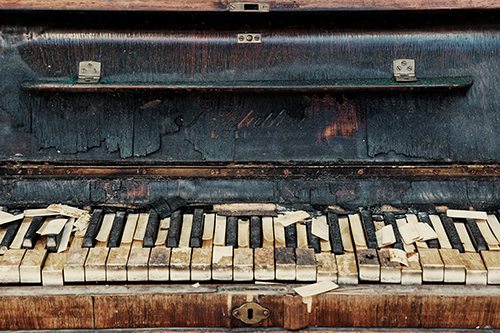Should I Refinish My Piano Myself?
Restoring an old piano can bring new life into an old and perhaps previously abandoned instrument, and it’s certainly worth your while if you have an old piano gathering dust in your garage or basement that you would like to make good use of.
Or perhaps you inherited your grandmother’s beloved instrument, but it’s fallen victim to scratches and dents and other aesthetic maladies which make you think twice about giving it the place of honor that it deserves in your living room. A restoration can make a dilapidated instrument into a fine one, though you should note that it’s not always worth the effort and money that it takes to restore an instrument to like-new condition. You can always consult with an expert beforehand, to make sure that it’s actually worthwhile to restore your instrument.
I will not tell you that you should avoid refinishing your piano as a do-it-yourself project at all costs – it can be a very rewarding experience if you are careful to follow the necessary steps and have an attention to detail. What I don’t recommend is taking on the full restoration yourself, or being lackadaisical about how you go about the refinishing work because it could all just prove to be a costly mistake in the end.
My advice to anyone considering restoring their own piano is that it’s a complex process, requires a lot of work (including dismantling the instrument), and simply isn’t something that you could finish in one Saturday afternoon. It’s a lot of work, and so it may actually be worth your time and money to leave the work to professionals.
Refinishing an old piano can be a fascinating and worthwhile undertaking, and will not be too much for you if you’ve got some experience with furniture restoration. If you decide that it’s worth it to dive into all of this refinishing work yourself, you’ll need to disassemble the piano cabinet as much as you can, and mask off all the keys and action.
It may The next step is stripping off all of the lacquer finish, before doing further prep work on the surface of the wood veneer that will entail thoroughly sanding every part of the cabinet to a flat finish. Before you can apply any stain or finish, you have to fix any structural problems as well as blemishes like scratches and dents, which can be done with wood filler.
Any parts of the veneer that are peeling off will need to be glued in place. Once all of this is done, you can apply pore filler by hand, and let it dry partially. Wipe it off, so that only a small amount remains, and then leave it to dry. After this is done, you can finally stain or paint the wood, depending on your preference, and then leave this to dry.
Thoroughly inspect and prepare every bit of the cabinet to ensure that everything is ready for you to start applying lacquer to the surface. Lacquer application will need at least several days for completion, because you will need to apply multiple coats and you have to be careful about fumes as well as ensuring that each coat is dry before applying the next.
These are the basic steps of refinishing a piano, and you should consider them thoroughly before making up your mind to refinish a piano yourself. You will need the time to complete them, as well as a number of supplies which you may not already have sitting in your garage, and it’s not for the impatient or the faint of heart.
A professional refinishing job may just be what you’re looking for if you don’t want to or cannot do it yourself. Restoring a piano will save you money compared to buying a new instrument, and having your piano refinished by a restoration artist will ensure that the instrument is handled by a professional at every step of the process.
This means that your family heirloom will be in safe hands at every step of the way, and you need not fret about potentially making a costly mistake. Ultimately, it’s up to you, but in many cases I would recommend a professional restoration just to be safe about it.
However, if you have the time and the skills and want to see the inner workings of your piano, you might still consider refinishing the instrument yourself. And sometimes there’s nothing like the satisfaction of refinishing your own instrument, because you will have a connection with it that simply wouldn’t be there in the same way otherwise.
At Cooper Piano, we offer both full and partial restorations, as well as repairs. I assure you that the expertise of our skilled technicians and restoration artists can revive your piano to its former glory, so you need not fret over the more difficult aspects of restoring it yourself. If you want to dive in and do the refinishing work on your own, our technicians can replace the soundboard and pin block using the finest materials for you, and if you screw things up too much they can right them.
Ultimately, it’s up to you to decide whether you want to refinish your piano on your own, and while I’ll caution that there are a few risks if you get it wrong, I won’t say that it absolutely should not be done this way.
image: http://3.bp.blogspot.com/-mh08-osQg30/TjI1JwE74xI/AAAAAAAADpU/aQfW2Fsm95k/s1600/piano+refinishing.jpg







